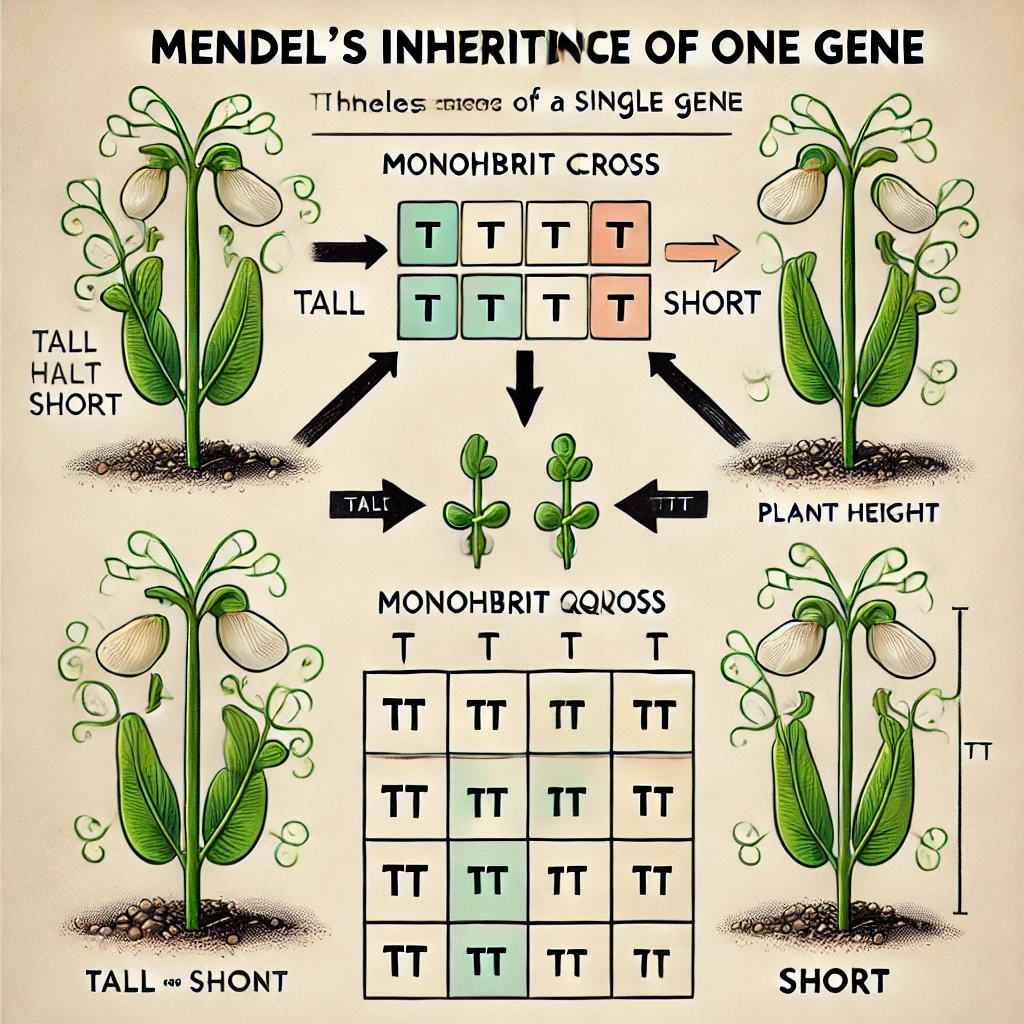Inheritance of One Gene is a foundational concept in Mendelian genetics, as established by Gregor Mendel in the 19th century. This principle explores how a single gene with two alleles controls a specific trait and is passed down from parents to offspring in predictable patterns. This fundamental genetic principle helps explain how physical traits are inherited and how variations arise in offspring.

Overview of Mendel’s Work
Gregor Mendel, an Austrian monk, conducted his groundbreaking research on inheritance using pea plants (Pisum sativum) due to their clear, distinguishable traits and ease of controlled breeding. Through his experiments, Mendel was able to outline several key laws of inheritance. The study of the inheritance of one gene specifically relates to what Mendel termed the Law of Segregation and the Law of Dominance.
Mendel chose specific traits in pea plants that exist in two contrasting forms, such as:
- Plant height: tall vs. short
- Seed color: yellow vs. green
- Flower color: purple vs. white
Mendel crossed pea plants with different characteristics to observe how these traits were passed to the next generation. His careful selection and documentation revealed predictable inheritance patterns.
1. The Law of Segregation
The Law of Segregation states that each organism has two alleles for each gene, one inherited from each parent, and these alleles segregate (separate) during the formation of gametes (sperm and egg cells). This means that each gamete contains only one allele for each gene. When two gametes combine during fertilization, the resulting offspring has two alleles for each gene, one from each parent.
Example: In pea plants, the gene for plant height has two alleles: T (tall) and t (short). If a plant has a genotype of Tt, it has one allele for tallness and one for shortness. During gamete formation, the alleles segregate so that each gamete has either a T or a t allele. When two gametes (from each parent) come together, they form combinations like TT, Tt, or tt in the offspring.
2. The Law of Dominance
The Law of Dominance states that when two organisms with contrasting traits are crossed, the trait that appears in the offspring is the dominant trait, while the trait that does not appear is the recessive trait. In a heterozygous condition (where the alleles differ, such as Tt), the dominant allele masks the recessive one, so the organism displays only the dominant trait.
Example: In Mendel’s pea plants, tallness (T) is dominant, and shortness (t) is recessive. When Mendel crossed a tall plant (TT) with a short plant (tt), all the F1 (first-generation) offspring were tall (Tt). Despite having a gene for shortness, these plants only exhibited the tall trait because the T allele was dominant over the t allele.
3. Monohybrid Cross and Punnett Square
To understand inheritance patterns, Mendel used a monohybrid cross, which examines one trait at a time. When he crossed two plants with different forms of a single trait (e.g., tall vs. short), he was able to predict the genotypic and phenotypic ratios of the offspring.
The Punnett square is a tool used to visualize the possible genetic outcomes of a cross. Here’s how it works in a monohybrid cross for plant height:
- Cross Tt x Tt (both parents are heterozygous for tallness).
- Set up a Punnett square to show possible gamete combinations:TtTTTTttTttt
- The Punnett square reveals the following results:
- Genotype ratio: 1 TT : 2 Tt : 1 tt
- Phenotype ratio: 3 Tall : 1 Short (since TT and Tt are tall, and tt is short)
This example illustrates that even though there are different genotypic combinations, the dominant trait (tall) appears three times as frequently as the recessive trait (short) in the offspring.
4. Genotype and Phenotype
- Genotype refers to the genetic makeup of an organism. It represents the alleles that an individual has for a particular trait (e.g., TT, Tt, or tt).
- Phenotype is the observable characteristic or trait that an organism displays, such as being tall or short in plants.
Example: In a monohybrid cross for height:
- TT and Tt plants have the same phenotype (tall) because of the dominant T allele, but they have different genotypes.
- The tt plants show the short phenotype due to the absence of the dominant allele.
5. Probability in Genetic Inheritance
Genetics often involves probability. Each time a cross occurs, the likelihood of different genotypes in the offspring can be calculated using a Punnett square. For instance, in a Tt x Tt cross, there’s a:
- 25% chance of TT (homozygous dominant)
- 50% chance of Tt (heterozygous)
- 25% chance of tt (homozygous recessive)
These probabilities illustrate the predictable ratios Mendel observed, even if the results may vary in a small sample.
6. Homozygous vs. Heterozygous Conditions
An individual’s genotype for a particular gene can be either:
- Homozygous: Having two identical alleles for a trait (e.g., TT or tt).
- Heterozygous: Having two different alleles for a trait (e.g., Tt).
Example: In the context of pea plants:
- TT (homozygous dominant) will be tall.
- Tt (heterozygous) will also be tall because of the dominant allele.
- tt (homozygous recessive) will be short.
7. Significance of Mendel’s Work
Mendel’s findings laid the foundation for modern genetics, showing that:
- Traits are passed down from parents to offspring in predictable ratios.
- Inheritance involves discrete units (genes), not a blend of traits.
- The principles of segregation and dominance apply to all sexually reproducing organisms.
8. Applications of Mendelian Genetics
Mendelian inheritance principles are crucial in various fields:
- Plant and Animal Breeding: Breeders use these principles to select for desirable traits, such as disease resistance, crop yield, or size in animals.
- Medical Genetics: Understanding Mendelian inheritance patterns helps in predicting the likelihood of genetic disorders in humans, especially single-gene disorders like cystic fibrosis or sickle cell anemia.
- Genetic Engineering: Geneticists use Mendelian principles to modify organisms for beneficial traits. By understanding inheritance, scientists can manipulate genes to develop crops with specific traits or study disease resistance.
9. Extensions and Exceptions to Mendelian Inheritance
Though Mendel’s principles provide a framework for understanding inheritance, modern genetics has identified some exceptions:
- Incomplete Dominance: In some cases, neither allele is completely dominant. For instance, in snapdragons, crossing red (RR) and white (rr) flowers yields pink offspring (Rr), showing a blending of traits.
- Codominance: Both alleles express themselves equally in the phenotype. An example is the AB blood type in humans, where both A and B alleles are fully expressed.
- Multiple Alleles: Some traits are controlled by more than two alleles, such as the ABO blood group system with three alleles (A, B, and O).
- Linked Genes: Genes located close together on the same chromosome tend to be inherited together, as they do not independently assort during meiosis. This violates Mendel’s Law of Independent Assortment.
- Polygenic Inheritance: Some traits, like skin color and height in humans, are controlled by multiple genes, resulting in a wide range of phenotypes.
10. Mendel’s Legacy in Modern Genetics
Mendel’s principles are still relevant and form the basis of genetics courses and research. With the discovery of DNA and advancements in genetic technology, scientists now understand inheritance at the molecular level, linking Mendel’s work to DNA structure and function.
Today, genetic research extends Mendelian concepts to more complex inheritance patterns and the molecular basis of gene function. These advancements contribute to breakthroughs in medicine, agriculture, and biotechnology, showing that Mendel’s findings have far-reaching implications beyond his original pea plant experiments.
Questions and Answers
- What is the principle of dominance in inheritance?
- Answer: The principle of dominance states that in a heterozygote, one allele (the dominant allele) can mask the expression of another allele (the recessive allele). For example, in pea plants, the allele for tall plants (T) is dominant over the allele for short plants (t).
- Define genotype and phenotype.
- Answer: Genotype refers to the genetic makeup of an organism, represented by the alleles it possesses (e.g., TT, Tt, or tt). Phenotype refers to the observable characteristics or traits of an organism that result from the interaction of its genotype with the environment (e.g., tall or short plants).
- What are alleles?
- Answer: Alleles are different versions of a gene that exist at the same locus on homologous chromosomes. For example, a gene for flower color may have a purple allele (P) and a white allele (p).
- Explain the concept of homozygous and heterozygous.
- Answer: An organism is homozygous for a gene if it has two identical alleles (e.g., TT or tt). It is heterozygous if it has two different alleles (e.g., Tt).
- What is a Punnett square, and how is it used?
- Answer: A Punnett square is a graphical tool used to predict the genotype and phenotype ratios of offspring from a genetic cross. It organizes all possible combinations of alleles from the parents to show potential genetic outcomes.
- What does Mendel’s law of segregation state?
- Answer: Mendel’s law of segregation states that during the formation of gametes, the two alleles for a trait segregate (separate) from each other so that each gamete carries only one allele for each gene.
- What is a test cross, and why is it performed?
- Answer: A test cross is a breeding experiment used to determine the genotype of an organism with a dominant phenotype. It involves crossing the organism with a homozygous recessive individual. If any offspring show the recessive phenotype, the organism must be heterozygous.
- Explain the difference between incomplete dominance and codominance.
- Answer: Incomplete dominance occurs when the phenotype of a heterozygote is intermediate between the phenotypes of the two homozygotes (e.g., red and white flowers producing pink flowers). Codominance occurs when both alleles in a heterozygote are fully expressed, resulting in a phenotype that shows both traits (e.g., red and white patches in flowers).
- What are sex-linked traits?
- Answer: Sex-linked traits are characteristics determined by genes located on the sex chromosomes (X or Y). These traits often show different inheritance patterns in males and females. For example, color blindness is a sex-linked trait found on the X chromosome.
- Describe the concept of lethal alleles.
- Answer: Lethal alleles are alleles that can cause the death of an organism when present in a certain genotype, typically in a homozygous state. An example is the allele for certain genetic disorders that result in embryonic lethality, leading to the absence of offspring carrying that genotype.






